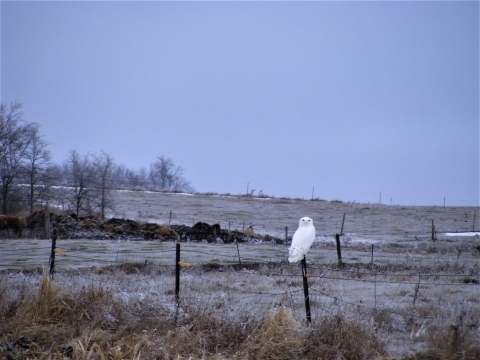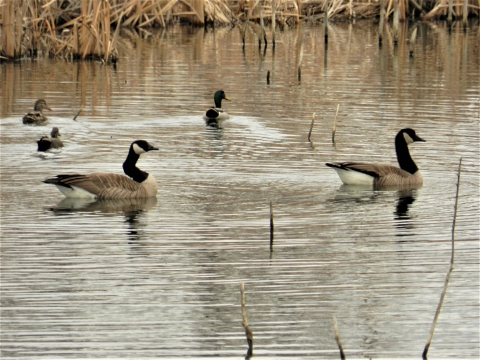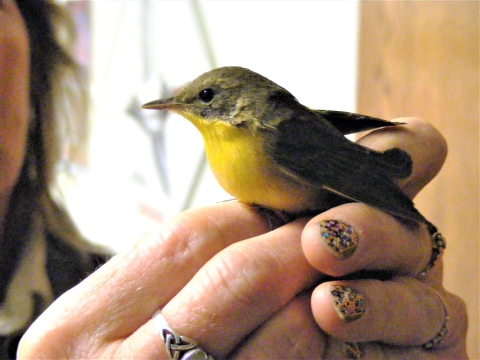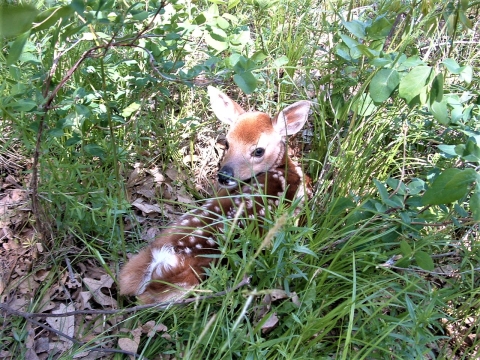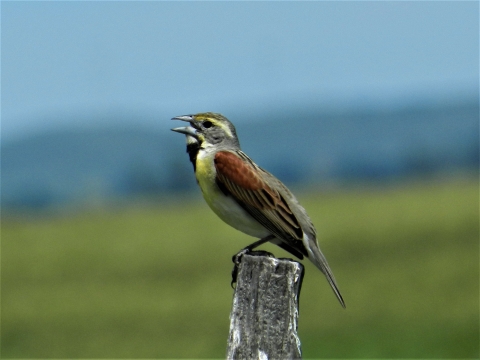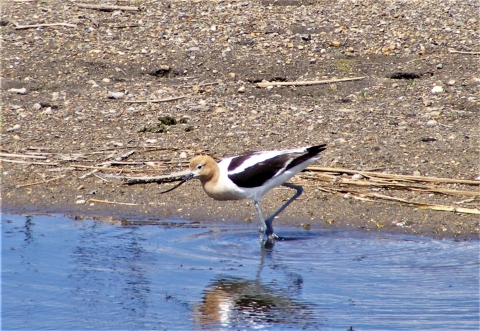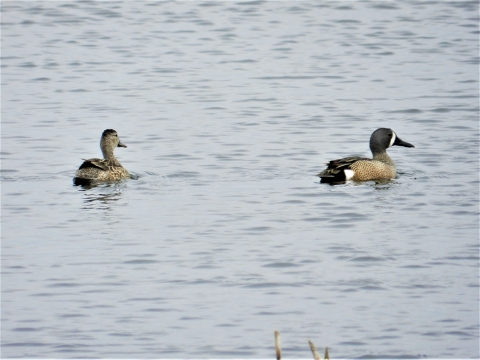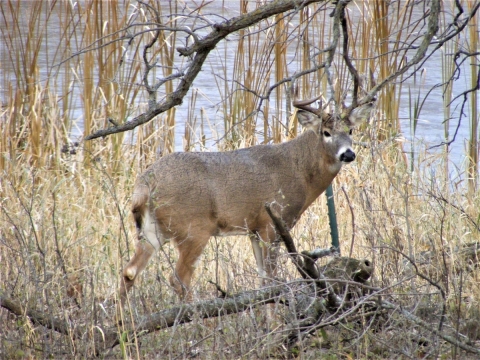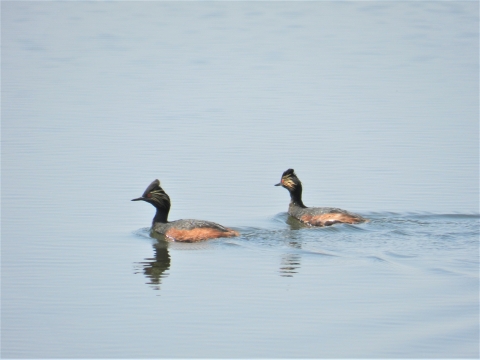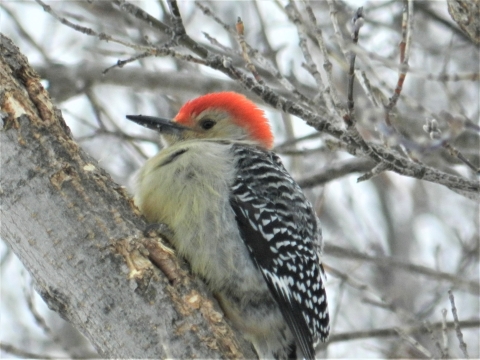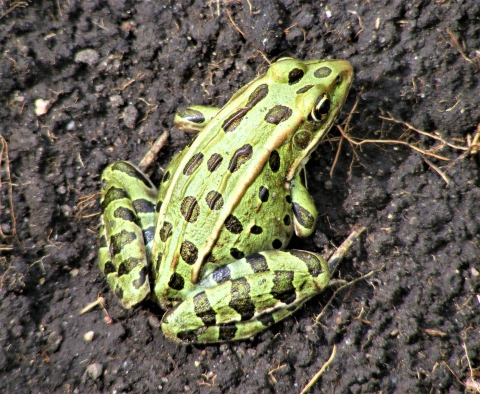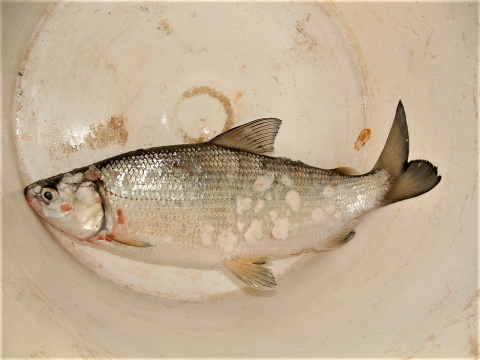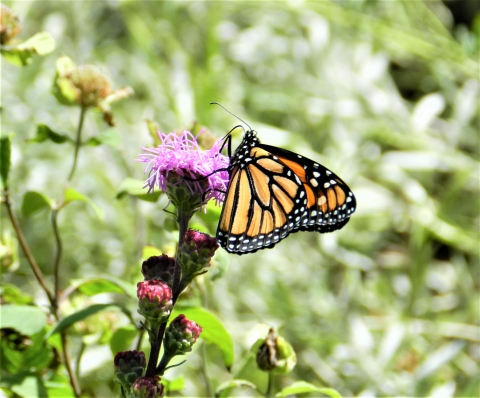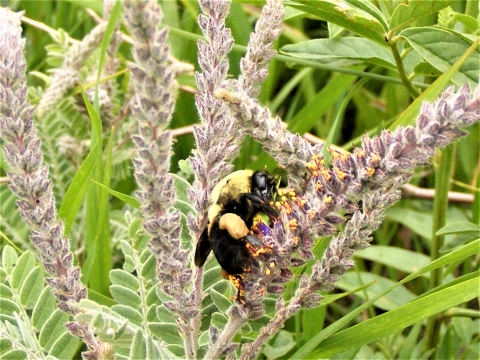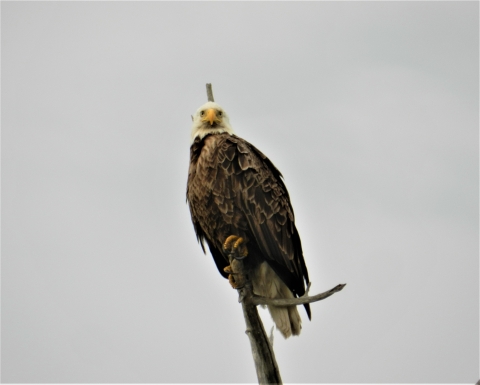Seasons of Wildlife
January
Cold and snow make life difficult for most animals in the Northern Great Plains but some birds actually consider this the southern part of their range. Look for Lapland longspurs, snow buntings and horned larks along roadsides and fields. Every few years snowy owls can also be seen during winter months.
February
Although it seems crazy, great horned owls are beginning to nest even though spring can still be months away. A few hardy Canada geese may venture out at the end of the month. During the winter, you can often find birds such as woodpeckers, nuthatches, sparrows, and chickadees. Mammals such as rabbits, squirrels, coyotes, and White-tailed deer are frequently seen in the colder months.
March
Just when you think winter will last forever, spring migrants begin to return. Look for waterfowl, especially white-fronted, snow, and Canada geese, goldeneyes and widgeon from mid- to late March and into April. Listen for sandhill cranes which can often be heard but not seen as they migrate north. Bald eagles can often be observed following waterfowl migrations. Our first passerines such as robins and meadowlarks also appear near the end of March.
April
When the ice and snow finally melt, the prairies come alive. Ducks and geese can be seen on nearly every wetland. American white pelicans also appear along with marsh birds like herons, egrets, grebes and coots. Yellow-rumped warblers as well as ruby- and golden-crowned kinglets herald the beginning of the warbler migration with their appearance at the end of April. Some of the larger shorebirds like avocets and willets appear at the end of the month.
May
Warblers are the star in May. Early in the month, birdwatching is easier before the trees leaf out allowing great opportunities to catch a glimpse of some of the many warblers that pass through. Some ducks such as mallards and pintails will already be nesting as will Canada geese. Shorebirds can now be seen alongside wetlands and in flooded fields. Listen for the snores and grunts of leopard frogs courting females.
June
Most of the birds just passing through (migrating) will be gone by now. Birds seen in June will probably be nesting here. Look for the first duck and goose broods. The first fawns will also make their appearance in June...though they are rarely seen.
July
Later nesting ducks like gadwall and blue-winged teal will be appearing with broods. Canada geese will be grouping up on large lakes in preparation for their flightless period during their molt, when they replace old feathers with new. By the end of the month some shorebirds will already be heading south from their northern breeding sites. Look for dickcissels and bobolinks in the grasslands.
August
As some wetlands dry up, mudflats are exposed, just in time for migrating shorebirds. Waterfowl are grouping up and feeding furiously to build up energy stores for fall flights.
September
Warblers and other passerines will be heading for warmer climates this month. Blue-winged teal are the last of the ducks to arrive in spring and the first to go in the fall. American coots may be everywhere one day and gone the next.
October
October is another big month for migration. Ducks and geese as well as tundra swans will be coming through before wetlands freeze up. Red-tailed hawks and eagles will also be heading south. At the end of the month look for common goldeneyes and buffleheads. White-tailed deer can be seen more often as they lose habitat to harvesting activities and bucks become more interested in does.
November
If water is still open, look for mergansers and grebes, the latest waterfowl migrants. If the weather is mild, other waterfowl and even egrets or herons may still be seen. Eagles can often be seen even after ice up. Coyotes and red fox may be seen or heard more often while looking for mice and rabbits for a winter feast.
December
By now only our hardy winter residents are left. Look for downy and hairy woodpeckers, black-capped chickadees and nuthatches. Sharp-tailed grouse and ring-necked pheasants can also be found year-round. White-tailed deer can be seen scrounging for food wherever they can find it. To find out more about which birds stick around for the winter join us for the Christmas Bird Count.
Featured Species
Even when it seems like there is nothing going on, whether in the heat of summer or the frigid winter, wildlife or signs of it, are everywhere.
Birds
The mix of habitats on the Refuge increase the number of species of birds likely to be seen. About 100 species nest on or near the Refuge and another 159 species have been observed during migrations. Woodlands are the best places to see warblers, orioles, vireos, and grosbeaks as well as the small forest hawks like Cooper's and sharp-shinned. The Spring Lake Overlook trail is a good place to look for grassland species like sharp-tailed grouse, bobolinks, savannah sparrows and sedge wrens. Check the wetlands both big and small for red-winged and yellow-headed blackbirds, great blue herons, ring-billed and California gulls, great egrets, and many different types of ducks and other waterfowl.
Changing water levels and seasons will bring different species so visit often. Please contact the Refuge if you would like a current bird list.
Ruddy Duck
Ruddy ducks are the clowns of prairie potholes with their bright blue bills and slapstick mating rituals and noises.
Mammals
Mammals are warm-blooded, have some hair covering their bodies, and provide milk to their young. They inhabit every type of habitat from oceans (whales), to the air (bats), and underground (gophers). Above ground they can be found in grasslands, woodlands, wetlands, and some have even made themselves at home in our homes. There are about 49 species of mammals that can be found on the Refuge and surrounding area. Most common are white-tailed deer, skunks, red fox, coyotes, woodchucks, and numerous species of mice, shrews, and voles.
Reptiles & Amphibians
Reptiles and amphibians together are considered herpetofauna, or herps for short. Herpetologists are biologists that study these animals. Some amphibians, particularly frogs, have been experiencing global declines due to loss of habitat, climate change climate change
Climate change includes both global warming driven by human-induced emissions of greenhouse gases and the resulting large-scale shifts in weather patterns. Though there have been previous periods of climatic change, since the mid-20th century humans have had an unprecedented impact on Earth's climate system and caused change on a global scale.
Learn more about climate change , disease, pesticide and herbicide use, and invasive species invasive species
An invasive species is any plant or animal that has spread or been introduced into a new area where they are, or could, cause harm to the environment, economy, or human, animal, or plant health. Their unwelcome presence can destroy ecosystems and cost millions of dollars.
Learn more about invasive species . Herps are vital parts of the ecosystem and scientists have even produced important medical compounds from amphibian skin.
There are 8 known species of amphibians and 9 reptiles that occur in the area. Most common are leopard and chorus frogs, tiger salamanders, garter and redbelly snakes, and painted and snapping turtles.
Fish
Fish in South Dakota lakes and ponds are considered warm water species. There are usually low numbers of game fish and high numbers of minnows, carp, and suckers in area waters. Before water levels rose in the 1990's, few if any game fish existed in Refuge lakes. Now there are good populations of yellow perch, northern pike, and walleye. To protect breeding waterfowl for which this Refuge was established, only ice fishing is allowed.
Invertebrates
Invertebrates make up more than 97% of the world's animal life. They are the work horses of the animal world. Few people appreciate all these creatures do for us and wildlife. They decompose plants and animals, are a source of food for many animals and people, eat pests that bother us as well as pollinate plants that benefit many farmers. Of course there are also invertebrates that are parasites, transmit diseases, can cause damage to our homes, bite or sting, and can be squishy, slimy, prickly or just generally unpleasant.
But they can also be beautiful and fascinating and help us to see when we are poisoning our environment. Recent problems with bees and colony collapse disorder should make us look closely at what we are doing to affect these animals. What happens to the smallest - and most numerous - will eventually affect us all.
Monarchs- Butterfly Royalty
Monarch populations have rebounded but they are still in trouble. Want to help these amazing insects? Enter your sightings at Journey North or e-butterfly.org and plant native milkweeds.
What's the Buzz?
Bees and other pollinators are declining due to habitat loss and pesticide use. Help monitor these fascinating flying bugs by grabbing your phone or camera and joining Bumble Bee Watch.
Threatened & Endangered Species
There are few federally threatened or endangered animal species that are known to occur at Waubay National Wildlife Refuge. Piping plovers have nested nearby but have not been seen in many years since high water levels have eliminated many sandy beaches around wetlands. The whooping crane will occasionally be seen migrating in this area.
Though once common over much of North America, the American burying beetle has disappeared from 90% of its range. Hypotheses explaining its decline range from deforestation, loss of available carrion in the required size since the extirpation of passenger pigeon and declines in prairie chickens, and increased competition for resources from skunks, raccoons, and other scavengers.
The bald eagle was recently removed from the endangered species list. Evidence of its success can be seen in the many nests that can be found throughout South Dakota and the country.
Dakota skipper and Poweshiek butterflies are candidate species for listing. They are small, fast flying butterflies found primarily in high quality native prairies. It is unknown what is causing the decline in these species though habitat loss is probably an important factor.


